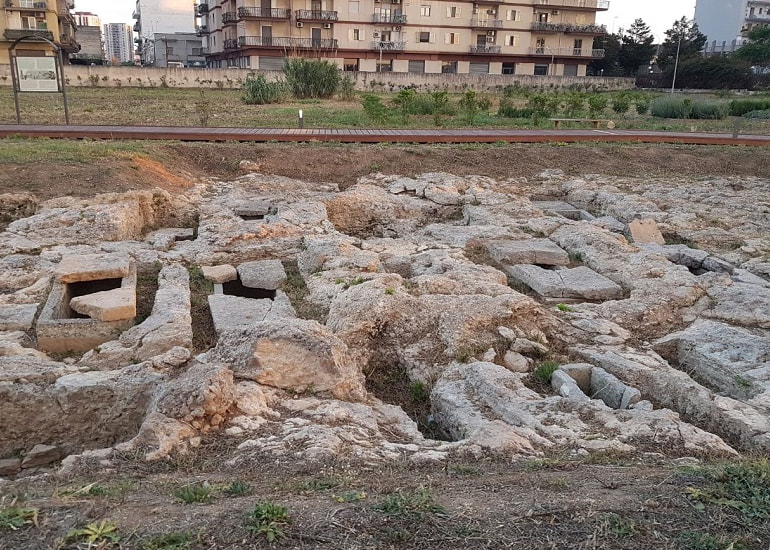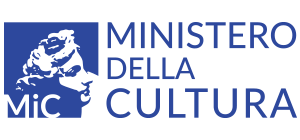What to see in Taranto
A CITY TO DISCOVER
Apulia is a land of unexpected treasures often found beyond the most travelled destinations. Among them, Taranto is certainly a jewel that stands out.
A journey to Taranto means discovering the “Città dei due mari” (City of the Two Seas), between the Mar Grande and Mar Piccolo, but it also means exploring a Spartan City, the only colony of Sparta built outside the Greek borders. Taranto is also an early medieval city, destroyed by the Saracens in the tenth century and a Byzantine city rebuilt in the tenth century. It is also the city from where the coffin of Frederick II set sail towards its final destination: its burial in the cathedral of Palermo and much, much more…
Taranto is also a city full of monuments: the Aragonese Castle, the Doric Temple (in Piazza Castello), and of course the National Archaeological Museum of Taranto.
What are the must-sees landmarks for a trip to Taranto, then?
Obviously, the MArTA!
The National Archaeological Museum of Taranto is hosted inside the former convent of the Alcantarini friars and with its 6,000 square meters is one of the major international museum focused on the history and civilization of Magna Graecia: here all the splendour of ancient and early medieval civilization can be admired along a chronological and thematic path.
You must not miss the figurative ceramics masterpieces, the tomb of the athlete and the Hall of Gold, full of goldsmithing artworks: gold foil diadems, necklaces, and rings that still today are a source of inspiration for fashion and design.
Tip: The Museum offers, in addition to guided tours and educational workshops, various activities such as digital craft laboratories, with 3D printers and scanners, laser cutting machines, robotics kits and educational classes.
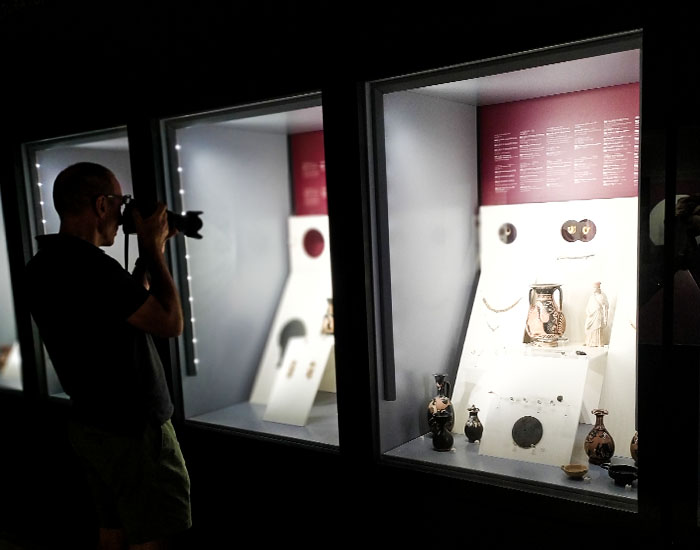
Taranto: the Old Town
It is the medieval part of the city, built in the tenth century over the ruins of the Greek acropolis and expanded both in width, by filling in the Mar Piccolo, and in height, with the elevation of the ancient palatial houses. In fact, until the unification of Italy it was forbidden to build outside the gate of Lecce (where now the navigable channel is located).
The thousand faces of the city are hidden in its stratigraphy, from the Neolithic to contemporary times. Strolling through Taranto’s streets, it is possible to admire Roman granite columns used as way side posts, hypogeal oil mills, coats of arms and votive shrines that convey the life of the city.
The main street, via Duomo, crosses the city in an east-west direction and matches the layout of the Via Appia. All the main palaces and the most important churches overlook it. In addition to its important role as an acropolis in the Greek era, the old town is an admirable example of Byzantine urban planning surrounded by its walls, visible along Via di Mezzo, and organized in courtyards, alleys and housing structures typical of the he Mediterranean Middle Ages.
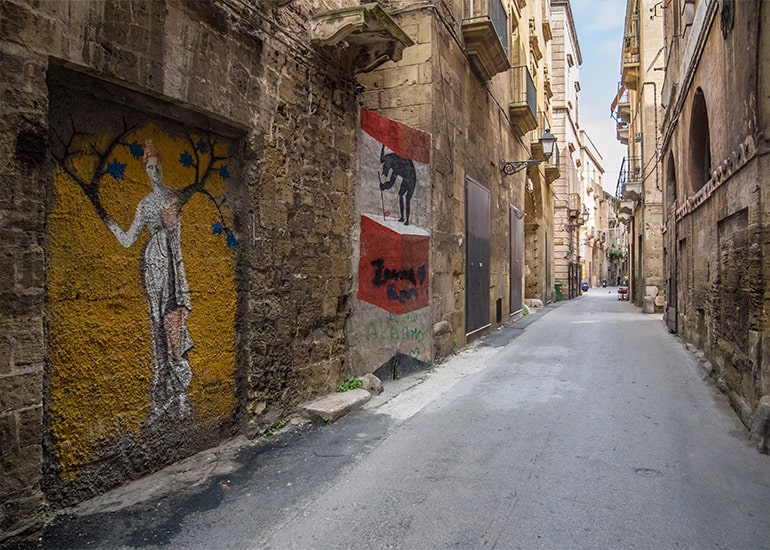
The Aragonese Castle
It was 1492 and, while Columbus was discovering the Americas, the coasts of Apulia were being raided by Turkish pirates. Ferdinand of Aragon wanted to inaugrate a new building built over the Greek and Byzantine fortifications: the Aragonese Castle (aka Castel Sant’Angelo), a symbol of the many peoples and cultures of this city and the centre of economic and military interests since always.
The renewed structure of the castle, with wide and low towers, was more suitable to withstand cannon shots: the recent discovery of gunpowder in fact made the previous high and narrow structures unsuitable.
After its partial demolition to make room for the swing bridge, in 1887, the building became the headquarters of the Navy, which since 2004 started archaeological works and is charge for its protection, preservation and guided tours.
Tip: the night tours are particularly charming, do not miss them!
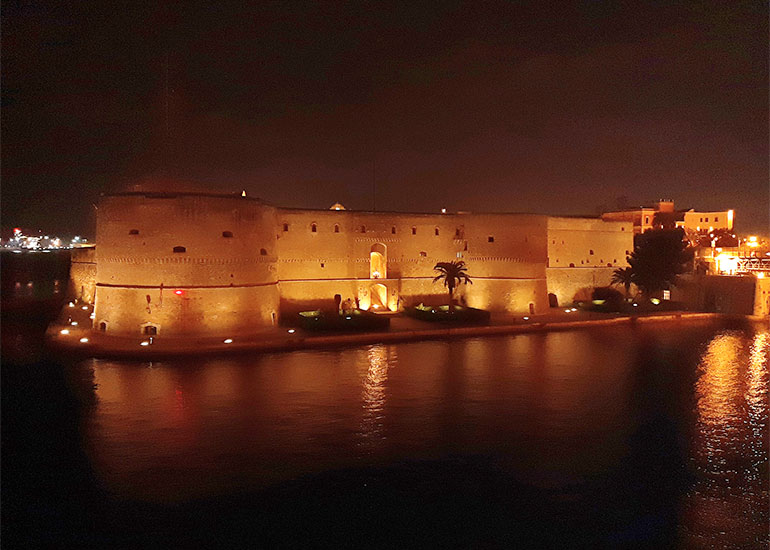
Doric Temple in Piazza Castello
Piazza Castello hosts a series of monuments: the Doric temple wedged next to the convent of San Michele, current headquarters of the G. Paisiello Institute of High Musical Education; the City Palace and the Aragonese Castle.
The many excavations performed across the square showed that the area was already busy back in the Neolithic Age and subsequent precolonial eras. The Doric temple is among the oldest of Magna Graecia and dates back to the first half of the sixth century BC. Specifically because of its archaic structure, it shows a number of construction peculiarities, such as the low height of the drums of the columns and the presence of rectangular holes in the intercolumniations used to fit the scaffolding during construction. The temple does not have any inner cell, likely made of perishable material. It was a hut of sorts called oikos. The sacred area, which was much larger than the current fencing, was modified and enriched several times by small votive shrines and finally destroyed in the Roman raid of the city dating back to 209 BC.
Popularly called temple of Poseidon, for an intuitive connection between Taranto and the Greek god of the sea, the sanctuary was probably dedicated to a female deity, and in fact until the nineteenth century was known as the temple of Diana.
The original structure had to have six columns on the front and thirteen on the long side.
The area of the Doric temple is full in stratigraphic and monumental superimpositions due to the many human settlements that called the city home until modern times. The Greek structures were incorporated in the Mastronuzzi Palace and in the eighteenth-century Oratory of the Trinity. Then were then demolished in the seventies of the twentieth century.
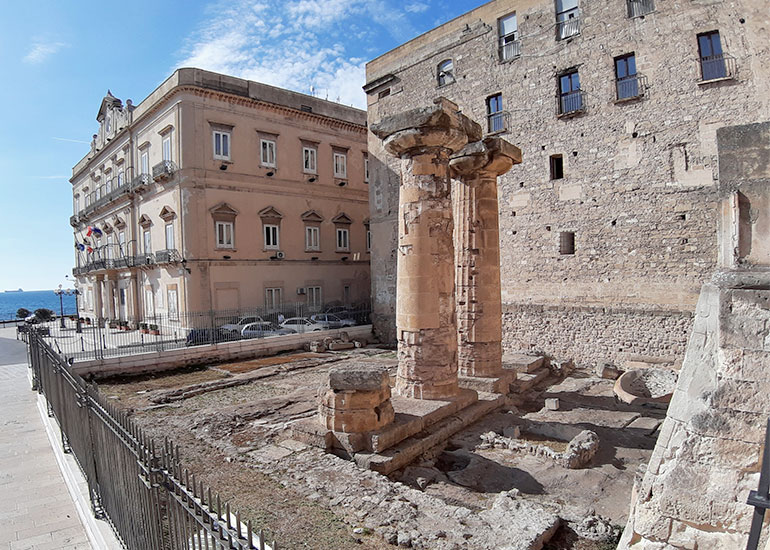
The San Cataldo Cathedral
The first news about the construction of this Romanesque basilica date back to 1071. On May 10 of that year, in fact, the historians report the miraculous discovery, in the chapel now used as the Baptistery, of the tomb of the Holy Bishop, traditionally considered to be of Irish origin and now of Lombard ethnicity, who died in Taranto at the end of the seventh century. Archaeological research showed that in the same area there was an early medieval necropolis and at least one older church, probably the Byzantine cathedral (tenth century) which is currently the chevet of the basilica. The Norman structure currently visible consists therefore of a structure with three naves, with transept and crypt. The taste of the time and the relatively short construction time explain the great use of reused materials, including Roman and Byzantine elements and only a few capitals made specifically for the project.
The floor incorporates the ruins of the mosaic made in 1160 by the Petroius Presbyter for Archbishop Giraldo, with figures of legendary beings (griffins, centaurs) inserted in circles decorated with inscriptions or plant motifs.
The current appearance of the cathedral dates back to the fifties, when a questionable restoration removed most of the Baroque decorations, but leaving those of particular value: the lacunar ceiling in gilded wood dating back between the seventeenth and eighteenth centuries, the ciborium of the presbytery (the medieval one is preserved in the Baptistery) with the wooden choir and especially the two side chapels of the Blessed Sacrament and the big chapel of San Cataldo.
The latter was started in 1630 and finished one hundred years later by Archbishop Pignatelli. All decorated with marble and mother-of-pearl inlays, it preserves in its altar of Neapolitan school the late-Roman sarcophagus in which the body of the patron was found, while the silver and gold statue of the saint overlooks the same altar.

Convent and Church of San Domenico Maggiore
A historical church showing Taranto’s religiousness in the heart of the Borgo Antico: the Good Friday procession, one of the most important city events, starts from here.
The church of San Domenico Maggiore belongs to a large complex, which also includes the convent under the leadership of the Dominicans since 1315.
It is a place that holds religious treasures from the most remote past: ruins of a Greek temple of the fifth century BC and, in Byzantine times, a very important imperial monastery dedicated to St. Peter was built here, already certified in the year 970.
The current church dates back to about the fourteenth century and was built in Gothic style.
Tip: do not miss the detail of the wonderful rose window on the facade and, if you watch carefully, at the sides of the sloping roof of the facade you will see two small reused Byzantine capitals.
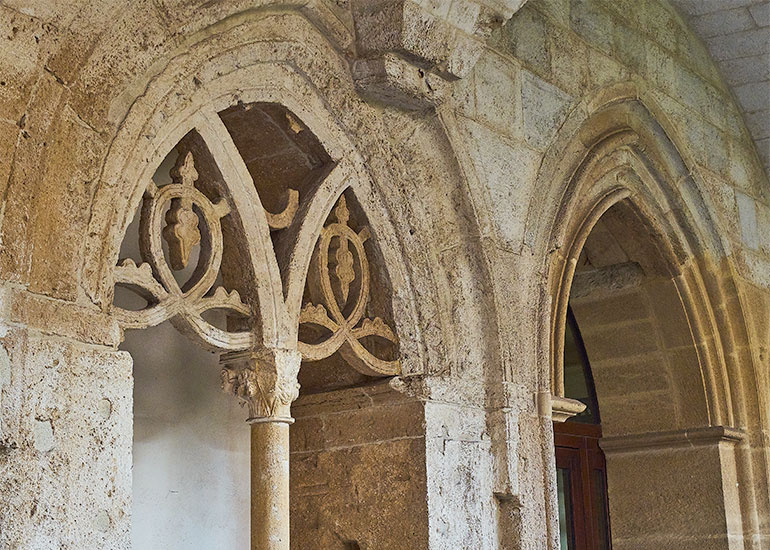
MUDI Diocesan Museum
Inaugurated on May 6, 2011, the Diocesan Museum of Sacred Art of Taranto (MuDi) is located in the restored spaces of the former archiepiscopal seminary, formerly Palazzo Muscettola.
It hosts, among other masterpieces, remarkable examples of liturgical furnishings of medieval, baroque and modern times, the largest engraved topaz in the world and a collection of embroidered cloths with Taranto byssus yarn obtained from the Pinna nobilis.
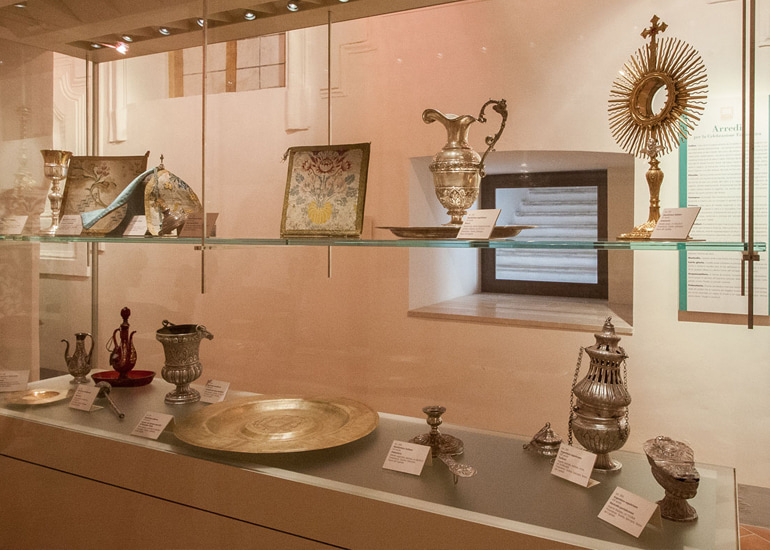
"A. Maiorano" Ethnographic Museum and Pantaleo Palace
Between 1770 and 1773 Baron Francesco Maria Pantaleo commissioned the construction of his palace at the western end of the Old Town. There you can admire a perfectly preserved patrician residence, which hosts the original eighteenth-century majolica floors and paintings by artist Domenico Carella. The palace houses the ethnographic museum dedicated to the scholar Alfredo Maiorano who donated his collection to the Municipality of Taranto and allowed setting up the museum. It is a jewel that tells the life of the people of the city, with their rituals, items and traditional activities.
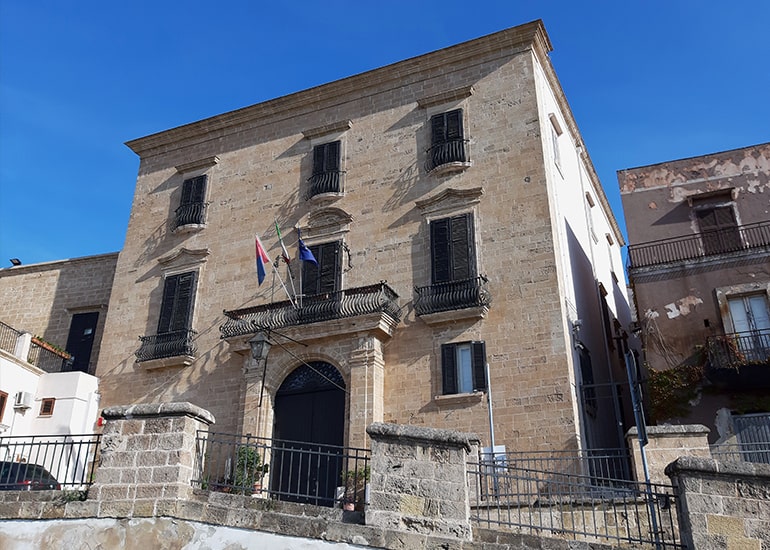
The Old Town hypogea
Medieval Taranto went through a construction period where housing, warehouses and production environments used rocks as the main material and were carved into the calcarenitic bank. Visiting it allows you to discover fascinating details ranging from ancient quarries to the Norman oil mills, ruins from the Greek acropolis, as well as Byzantine and medieval fortifications until the funeral hypogea of the modern times.
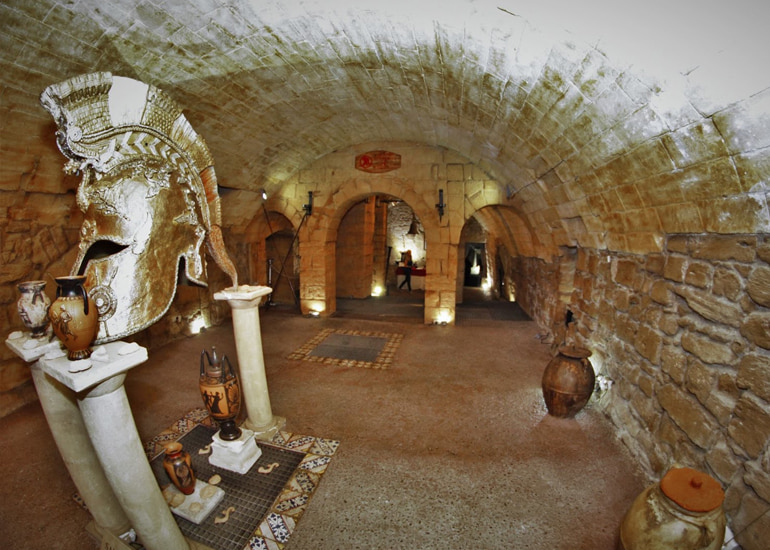
Umbertino Village and the New Town
The Borgo district was built starting from the end of the nineteenth century based on urban planning designed by architect Davide Conversano and carried out by Giovanni Galeone at the same time of the installation of the Military Arsenal in the city. The urban structure, inspired by Positivism, called for wide blocks separated by an orthogonal road network that destroyed the ancient roads. The main streets, which today are called via D’Aquino and via Di Palma, connect the canal with the monumental entrance of the Arsenal.
The district is located where the Greek, Roman and early medieval city until the tenth century were located.
The noble palaces generally fill the entire block and are fine examples of neoclassical or liberty architecture. The first palace built in the Borgo is Palazzo Amelio, almost in front of the Swing Bridge.
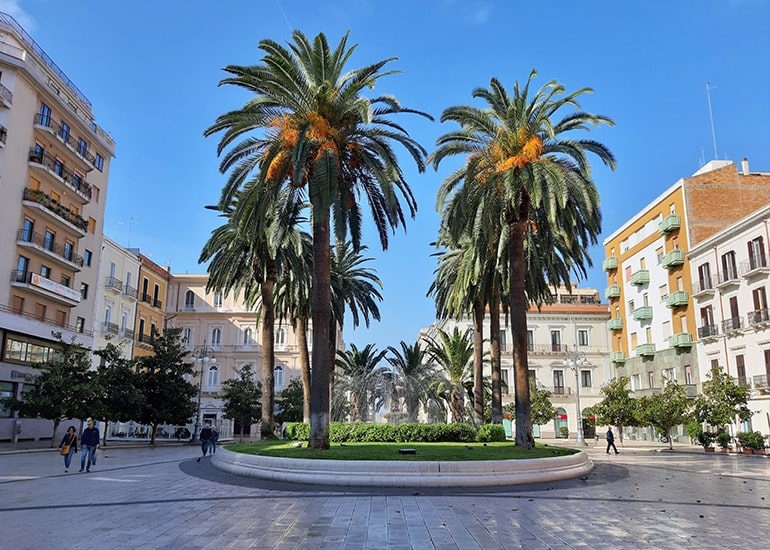
The Swing Bridge
It is the most recent symbol of the city: it stands on a canal 83 meters wide and 400 meters long, and connects Mar Piccolo and Mar Grande.
Until recently, the bridge would be opened and closed several times a day, and each time the procedure would attract tourists. However, with the decommissioning of the shipyards in the Mar Piccolo, the procedure became much less frequent.
The first structure of the bridge dates back to May 22, 1887, and was a work of extraordinary engineering back then perfect to connect the old and new city. The opening mechanism was operated by a hydraulic system driven by emptying a huge cistern located in a tower of the Castle.
At the end of the fifties of the twentieth century the bridge was renovated with the addition of an electric system.
Tip: during the San Cataldo celebrations, held on 8 May, the statue of the saint is loaded on a ship and carried in procession by sea followed by many boats. When it enters the channel, the castle is set ablaze with fireworks.
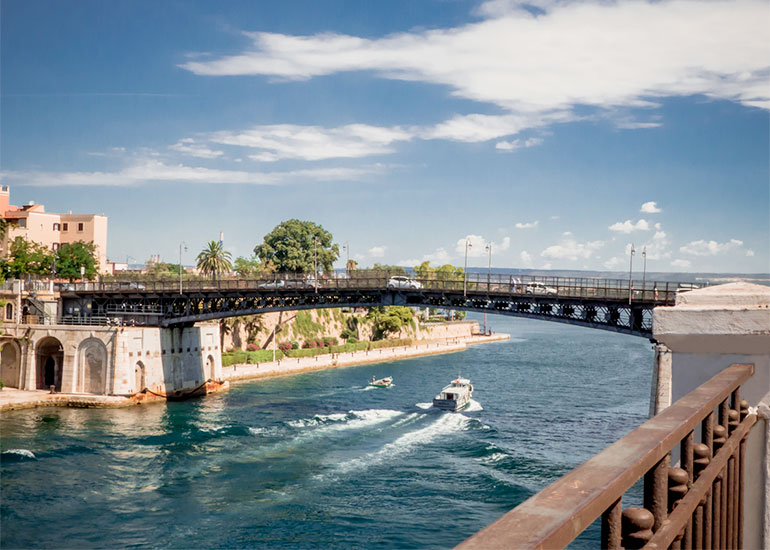
Seashore promenade and Mar Piccolo
The road that overlooks Mar Grande from the Canal heading towards the east is named after Vittorio Emanuele III of Savoy and is commonly referred to as the Promenade. It was built in the first half of the twentieth century, when the government wanted to create in the city a scenario of great scenic impact as a reference to the Navy military base.
In fact, large monumental buildings overlook the promenade, such as the Prefecture/Province Palace, Post Office Headquarters, Bank of Italy and former Casa del Fascio, internally decorated with frescoes by artist Mario Prayer.
The view on the sea is spectacular: the games of light at the different hours of the day, the walks on the seashore and beaches being created, restoring the establishments of the Belle Epoque make it enchanting. In the days of north wind is possible to see the outlines of the mountains of Apulia, Basilicata and Calabria. The most impressive outline is that of the massif of Mount Pollino, followed by the plain of Sibari and the first outlines of the Sila. The whole outline of the Ionian Magna Graecia is visible from Taranto.
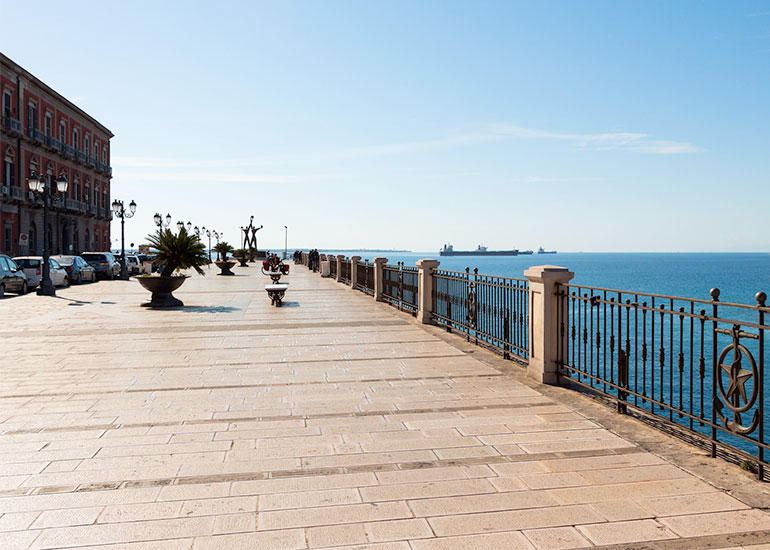
Church of the Carmine
Along via D’Aquino stand two important monuments: Palazzo degli Uffici, currently under restoration, and the Chiesa del Carmine.
The former originates from the transformation of a former orphanage dating back to 1789 into the headquarters of the court and the city offices when the Borgo was being built.
The Carmine church and convent, instead, date back to the sixteenth century outside Porta Lecce, in an area called Li Lazzari, whose lazaret is documented since the fourteenth century. It was originally dedicated to both Santa Maria della Misericordia and Santa Maria Maddalena. The Carmelites were in charge of it since 1595, when the church was under their leadership but was in ruins, until 1609 when, with the help of the alms of the faithful, the new church was built. The current facade dates back to 1937 when the whole Piazza della Vittoria was reorganised.
In the afternoon of the Holy Thursday the poste dei perdoni takes place: pairs of the Carmelitans Confraternity hooded and wearing their traditional clothing walk slowly through the streets of the Old Town and the Borgo heading to the churches to visit the Sepulchers. At 5 p.m. on Good Friday, the procession of the mysteries emerges from the church, accompanied by bands playing traditional Taranto marches and heading through the streets of the Borgo (in exceptional cases in the Old Town) to then return at 7 a.m. of the following morning.
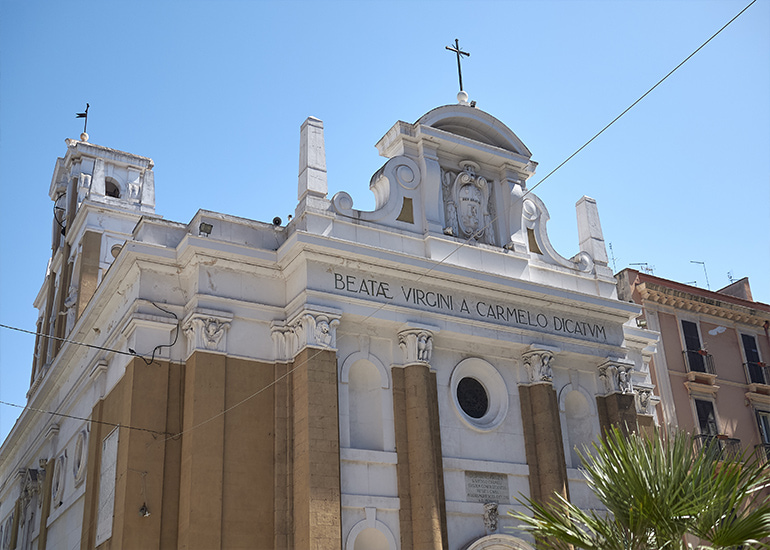
Church of San Pasquale di Baylon
The church and convent of the Alcantarine fathers were built between 1736 and 1794. The church is a beautiful example of eighteenth-century architecture, decorated with paintings by important local artists of Neapolitan school, which recently were displayed in a small but beautiful art gallery.
The facade of the church and convent were later transformed in neoclassical style. The convent and the adjoining garden were then used as the headquarters of the National Archaeological Museum of Taranto.
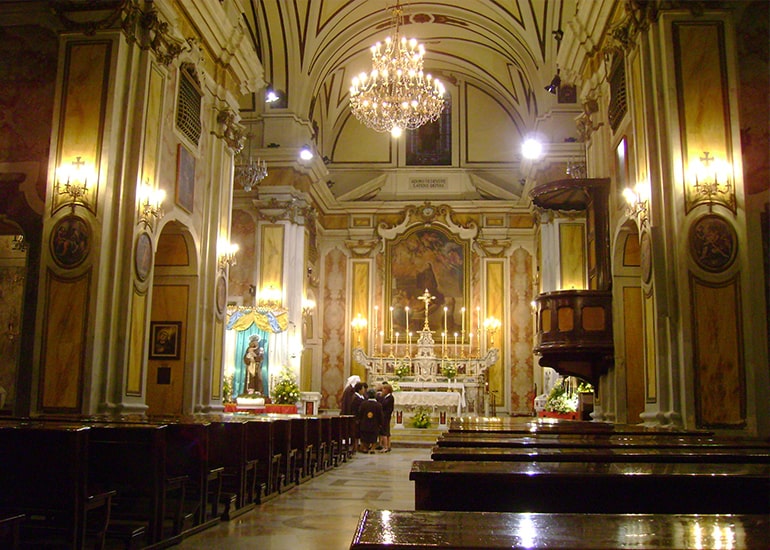
Church of San Giovanni di Dio also called of the Sacred Crucifix
The first parish of the Borgo. Church and convent were built close to the Greek agora/Roman forum and the amphitheatre around 1363, as the headquarters of the first Clarisse nuns who came to the city. The headquarters of the Carmelite Fathers ordered the construction of their convent, it was then in the Napoleonic era (1808) used as a hospital and is still home to a health centre. The recently renovated convent shows an interesting refectory and a charming cloister.
In 1897, on the initiative of Archbishop Jorio, the wooden crucifix and the statue of St. Antonio were brought here from the nearby monastery, already in ruins.
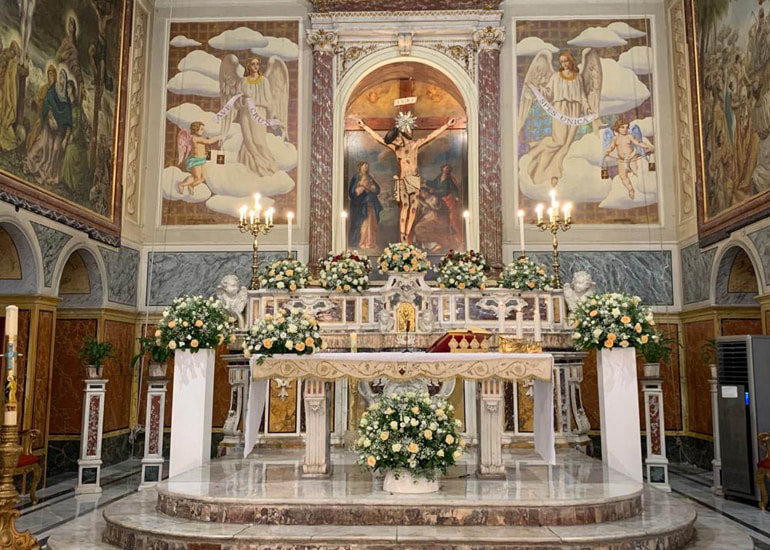
Convent of Sant'Antonio
As the MIC headquarters, the complex was built on a site full of ancient ruins in 1477, on the initiative of the last prince of Taranto, Giovanni Antonio del Balzo Orsini. Fallen into ruin and deconsecrated, the complex became a prison until the recent restoration and its new function as the headquarters of the Ministry of Culture.
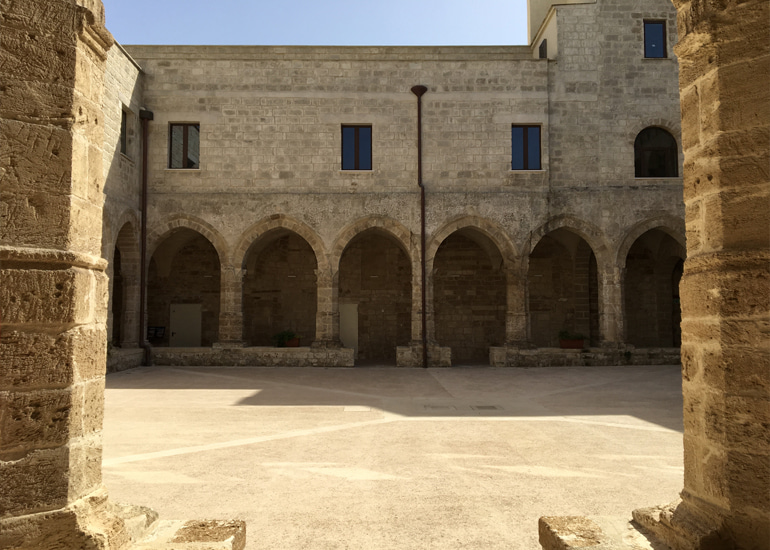
Underground Taranto
In the modern districts of Taranto, which stand over the Greek necropolis, you can visit some of the most important chamber-tombs found in the city; in Via Crispi at the corner with Via Pitagora there is the tomb of the athletes, in which the members of a male association that was recognised as the status symbols of athleticism and symposium dating back to the beginning of the fifth century BC were buried. The other chamber tombs, however, date back to the Hellenistic period and are decorated with coloured plasters and meander motifs that still hold all their splendor.
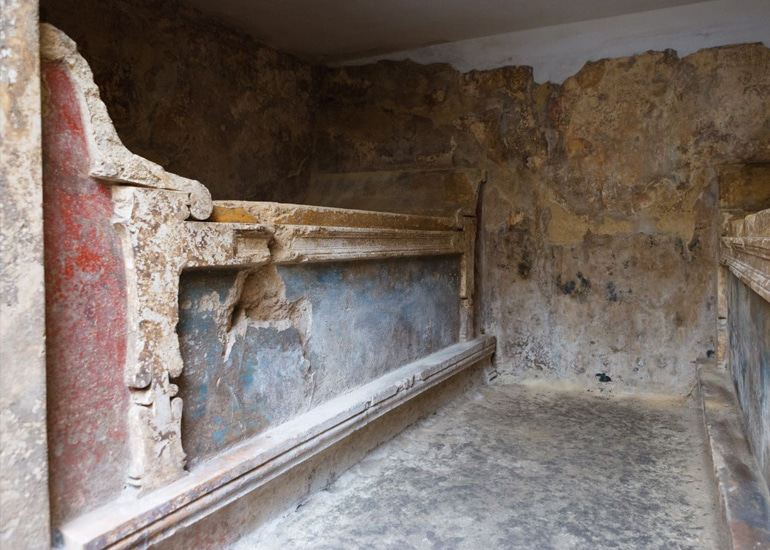
Gran Madre di Dio Co-cathedral by Giò Ponti
In 2021, the co-cathedral of Taranto celebrated its fifty years.
The church was a wish of the Archbishop of the time, Guglielmo Motolese, who wanted to create a new cathedral in the districts of new urban expansion. The construction of a second cathedral was possible because historically the city has two patron saints: San Cataldo and Maria Madre di Dio. In fact, the earliest information on the local church speaks of a cathedral dedicated to Santa Maria Genitrice.
Architect and designer Giò Ponti was commissioned to design the new church. The collaboration and the strong empathy between the client and the architect, that remind more of a renaissance order than a contemporary one, allowed the construction of an imposing structure, inspired by the relationship between Taranto and the sea, where the game of light, the concrete sail with the eighty openings, the same liturgical and furnishing elements were designed and built specifically for this church from whose sail, as Giò Ponti wrote, angels can look out.
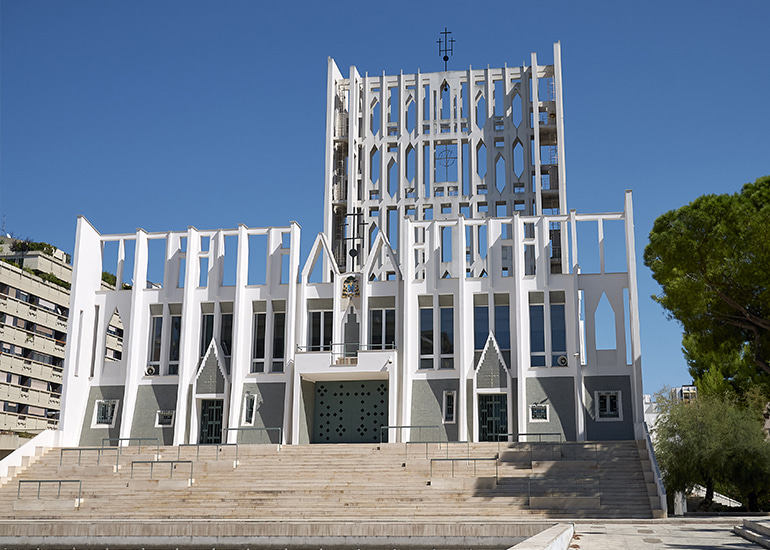
Archaeological parks of the Greek walls
At the eastern end of the city you can admire the sectors of the Greek walls (end of fourth/beginning of fifth century B.C.) preserved from the invasive building expansion.
Greek walls near the church Madonna della Fiducia – via Puglie
“Pierre Wuillemier” archaeological park of the walls – via Venezia
“Enzo Lippolis” Archaeological Park of Collepasso – via Mario Rondinelli 20
In both parks, it is possible to admire the isodomic structures, that is those made of perfectly squared blocks all of the same size. In the “Enzo Lippolis” park you can see the stratigraphic sequence of the necropolis obliterated by the most recent fortification.
